
Myliobatiformes is one of the four orders of batoids, cartilaginous fishes related to sharks. They were formerly included in the order Rajiformes, but more recent phylogenetic studies have shown the myliobatiforms to be a monophyletic group, and its more derived members evolved their highly flattened shapes independently of the skates.

Dasyatis is a genus of stingray in the family Dasyatidae that is native to the Atlantic, including the Mediterranean. In a 2016 taxonomic revision, many of the species formerly assigned to Dasyatis were reassigned to other genera.

The scaly whipray is a species of stingray in the family Dasyatidae, found in the tropical Indo-West Pacific oceans from the Red Sea and Mauritius to Indonesia. Its width is up to 22 cm (8.7 in), and it may reach 65 cm in total length.

Himantura is a genus of stingray in the family Dasyatidae that is native to the Indo-Pacific. In a 2016 taxonomic revision, many of the species formerly assigned to Himantura were reassigned to other genera.

Urogymnus is a genus of stingrays in the family Dasyatidae from marine, brackish and freshwater habitats in the Indo-Pacific and tropical East Atlantic regions. The genus was previously considered to be monotypic, containing only the porcupine ray. Molecular phylogenetic research published in 2016 reassigned several species from Himantura to Urogymnus.

The whiptail stingrays are a family, the Dasyatidae, of rays in the order Myliobatiformes. They are found worldwide in tropical to temperate marine waters, and a number of species have also penetrated into fresh water in Africa, Asia, and Australia. Members of this family have flattened pectoral fin discs that range from oval to diamond-like in shape. Their common name comes from their whip-like tails, which are much longer than the disc and lack dorsal and caudal fins. All whiptail stingrays, except the porcupine ray, have one or more venomous stings near the base of the tail, which is used in defense. They range in size from 0.18 to 2.0 m or more across in the case of the smalleye stingray and giant freshwater stingray.

The reticulate whipray or honeycomb stingray is a species of stingray in the family Dasyatidae. It inhabits coastal waters in the western Indian Ocean including the Red Sea, Natal and the Arabian Sea; also a Lessepsian transmigrant in the eastern Mediterranean. A large species reaching 2 m (6.6 ft) in width, the reticulate whipray has a diamond-shaped pectoral fin disc and an extremely long tail without fin folds. Both its common and scientific names refer to its ornate dorsal color pattern of many small, close-set dark spots or reticulations on a lighter background. However, the reticulate whipray is only one of several large spotted stingrays in the Indo-Pacific which, coupled with the variability of its coloration with age and locality, has resulted in a great deal of taxonomic confusion.

Taeniura is a genus of stingrays in the family Dasyatidae. The species Taeniurops grabata and T. meyeni were formerly placed in this genus. However, phylogenetic research has shown that these two species are not closely related to T. lymma, and they have been assigned to a separate genus, Taeniurops.
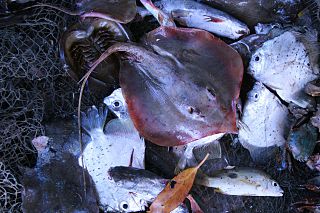
Brevitrygon walga, the dwarf whipray or mangrove whipray, is a small stingray, a cartilaginous fish in the family Dasyatidae. It is a demersal fish and is found over the continental and insular shelf of the west central Pacific Ocean where it is heavily fished. The IUCN has assessed it as being "near-threatened".
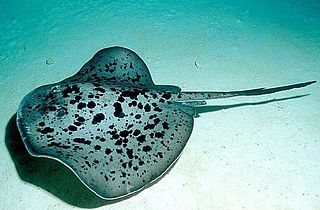
Taeniurops is a genus of stingrays in the family Dasyatidae. Its two species were formerly contained within the genus Taeniura.

Bathytoshia is a genus of stingrays in the family Dasyatidae found worldwide in tropical and warm temperate oceans. It was formerly regarded as a junior synonym of the genus Dasyatis.

Hemitrygon is a genus of stingrays in the family Dasyatidae from marine, brackish and freshwater habitats in the central Indo-Pacific and northwest Pacific regions. The genus was formerly regarded as a junior synonym of the genus Dasyatis.

Hypanus is a genus of stingrays in the family Dasyatidae from warmer parts of the East Pacific and Atlantic, including the Caribbean and Gulf of Mexico. The genus was previous regarded as a junior synonym of the genus Dasyatis.

Telatrygon is a genus of stingrays in the family Dasyatidae from the central Indo-Pacific. Its species were formerly contained within the genus Dasyatis.
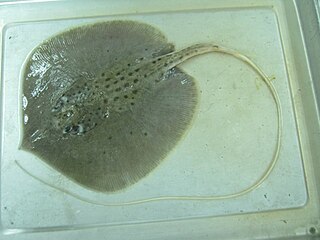
Fluvitrygon is a genus of stingrays in the family Dasyatidae from freshwater in southeast Asia. Its species were formerly contained within the genus Himantura.
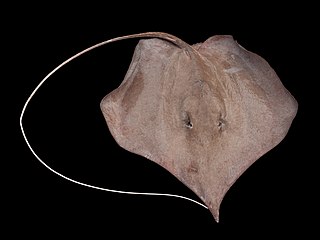
Fontitrygon is a genus of stingrays in the family Dasyatidae found in coastal tropical Atlantic waters and rivers that drain into the Atlantic. Fontitrygon species were formerly contained within the genus Dasyatis.

Maculabatis is a genus of stingrays in the family Dasyatidae from the Indo-Pacific. Its species were formerly contained within the genus Himantura.

Pateobatis is a genus of stingrays in the family Dasyatidae from the Indo-Pacific. Its species were formerly contained within the genus Himantura.
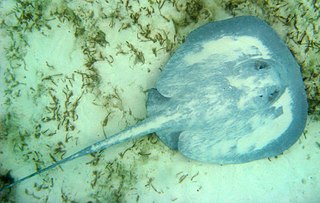
Styracura is a genus of stingray in the family Potamotrygonidae and the only genus in the subfamily Styracurinae. The two species in this genus were formerly included in Himantura, but were moved to Styracura in 2016 based on morphology and molecular evidence. Unlike other members of the family Potamotrygonidae, also known as freshwater stingrays, Styracura are found in the tropical West Atlantic and East Pacific.
Maculabatis ambigua, Baraka's whipray, is a species of stingray in the family Dasyatidae. It is found in the Western Indian Ocean: from the Red Sea south to Tanzania and the island of Zanzibar. This species reaches a length of 90 cm (35 in).



















